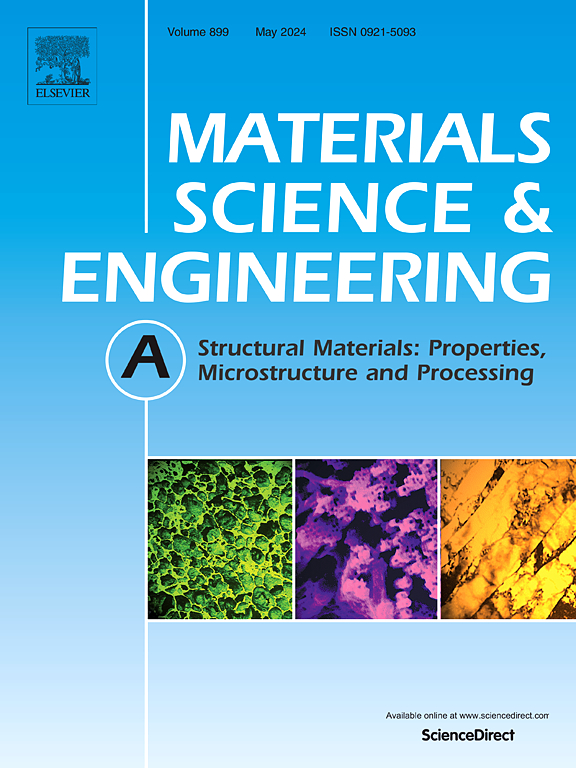Low critical stress induced large elastocaloric effect in Fe-doped Ni-Mn-Ti alloys with enhanced mechanical properties
IF 7
2区 材料科学
Q1 MATERIALS SCIENCE, MULTIDISCIPLINARY
引用次数: 0
Abstract
The elastocaloric effect in shape memory alloys is primarily attributed to the release of latent heat accompanied by stress-induced martensite transformation, which endows them with significant potential in solid-state cooling technology. However, the progress in developing Ni-Mn-Ti-based elastocaloric alloys for durability and miniaturization applications is severely hindered by their poor mechanical properties and the high critical stress during martensite transformation. In this study, Fe alloying was employed to solve these two problems, and Ni50-xMn33Ti17Fex (x = 0, 1, 2, 3, 4) alloys with <001> austenite orientation were successfully produced using directional solidification technology. The addition of Fe introduces a Fe-rich phase with high hardness and elastic modulus, thereby improving mechanical properties. Simultaneously, Fe alloying raises the phase transformation temperature and promotes the formation of numerous martensite domains, which serve as growth nuclei for further martensite development. This effectively reduces the critical driving stress required for stress-induced martensite phase transformation. Among these directionally solidified alloys, we found that the Ni46Mn33Ti17Fe4 alloy exhibits superior comprehensive performance with a value of 0.33 K MPa−1, which indicates that significant cooling effects can be achieved under low stresses. Meanwhile, the Ni46Mn33Ti17Fe4 alloy shows excellent mechanical properties including a compressive strength of up to 2250 MPa and a compressive strain of 78 %, enduring 1882 cycles with remarkably functional stability.
低临界应力诱导掺铁Ni-Mn-Ti合金的大弹性热效应,提高了合金的力学性能
形状记忆合金的弹性热效应主要是由于潜热释放伴随着应力诱导马氏体转变,这使其在固态冷却技术中具有很大的潜力。然而,ni - mn - ti基弹性热合金的耐久性和小型化应用受到其力学性能差和马氏体相变临界应力高的严重阻碍。在本研究中,采用Fe合金化来解决这两个问题,Ni50-xMn33Ti17Fex (x = 0,1,2,3,4)合金<;001>;利用定向凝固技术成功制备了奥氏体取向。铁的加入引入了具有高硬度和高弹性模量的富铁相,从而改善了机械性能。同时,Fe合金化提高了相变温度,促进了大量马氏体域的形成,这些马氏体域是马氏体进一步发展的生长核。这有效地降低了应力诱导马氏体相变所需的临界驱动应力。在这些定向凝固合金中,Ni46Mn33Ti17Fe4合金表现出优异的综合性能,|ΔTad/σcr|值为0.33 K MPa−1,表明在低应力条件下可以取得显著的冷却效果。同时,Ni46Mn33Ti17Fe4合金表现出优异的力学性能,抗压强度高达2250 MPa,压缩应变为78%,可承受1882次循环,功能稳定性显著。
本文章由计算机程序翻译,如有差异,请以英文原文为准。
求助全文
约1分钟内获得全文
求助全文
来源期刊

Materials Science and Engineering: A
工程技术-材料科学:综合
CiteScore
11.50
自引率
15.60%
发文量
1811
审稿时长
31 days
期刊介绍:
Materials Science and Engineering A provides an international medium for the publication of theoretical and experimental studies related to the load-bearing capacity of materials as influenced by their basic properties, processing history, microstructure and operating environment. Appropriate submissions to Materials Science and Engineering A should include scientific and/or engineering factors which affect the microstructure - strength relationships of materials and report the changes to mechanical behavior.
 求助内容:
求助内容: 应助结果提醒方式:
应助结果提醒方式:


